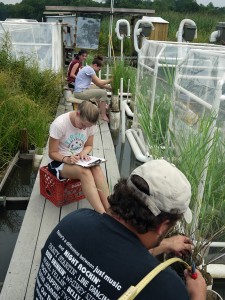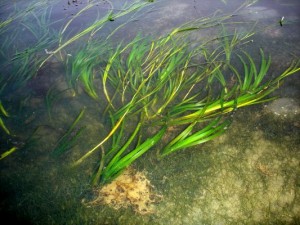
Seal collects data with other interns for Smithsonian scientists who are investigating the impact of global change on tidal marshes.
Click to continue »


Seal collects data with other interns for Smithsonian scientists who are investigating the impact of global change on tidal marshes.
Hallmark may not have a card for it, but today is International Mangrove Action Day.
The occasion is a small but vibrant tradition that has been observed annually on July 26th for nearly a decade in countries around the globe, including the U.S., India, Ecuador, Micronesia and many others. To celebrate, some communities organize protests or restoration projects. Some convene discussions or offer educational lectures about mangrove ecology. Others simply take a moment to appreciate the importance of mangrove forests.
Click to continue »

Around the world seagrasses are being lost. Turbidity is one factor that impedes their growth. However, in some places water quality has improved, but the grasses have not rebounded. SERC scientists wonder if a 'carpet of fluff'—a mix of organic and inorganic particles that floats just above the sediment—is blocking the sunlight seedlings need to grow. Photo: Tim Carruthers courtesy of IAN/UMCES.
Scientists Find Excess Nitrogen Favors Plants That Respond Poorly to Rising CO2
As atmospheric carbon dioxide levels rise, so does the pressure on the plant kingdom. The hope among policymakers, scientists and concerned citizens is that plants will absorb some of the extra CO2 and mitigate the impacts of climate change. For a few decades now, researchers have hypothesized about one major roadblock: nitrogen.Plants build their tissue primarily with the CO2 they take up from the atmosphere. The more they get, the faster they tend to grow—a phenomenon known as the “CO2 fertilization effect.” However, plants that photosynthesize greater amounts of CO2 will also need higher doses of other key building blocks, especially nitrogen. The general consensus has been that if plants get more nitrogen, there will be a larger CO2 fertilization effect. Not necessarily so, says a new paper published in the July 1 issue of Nature.
Click to continue »
Of the approximately 2,000 known species of living dinoflagellates, about 150 are parasitic. These organisms can alter the marine food web, in some cases destroying prey that consumers like copepods and larval fish rely upon. Coats first spotted T. acutus in the 1980s, in plankton samples he had collected from the Chesapeake Bay. Through his microscope, he noticed a ciliate being edged out of its lorica (shell) by a dinoflagellate. It looked different from others he had observed.
Click to continue »
The Smithsonian Environmental Research Center’s outreach coordinator, Karen McDonald, has assumed a second title: beekeeper. This spring she and Elio Cruz, from the National Museum of Natural History, set up three hives in a remote field on SERC’s campus. The bees feast on the nectar and pollen of tulip poplars, walnut trees, clover and other nearby plants. With help from NMNH’s Insect Zoo, McDonald is doing her part to help the struggling bees.
Have scientists figured out what’s causing Colony Collapse Disorder (CCD)?
No. They’ve been studying the large-scale losses of hives since American beekeepers began reporting the phenomenon in 2006. Scientists think a combination of factors—not just one—is leading to CCD. They’re currently exploring the role of pesticides, parasites, pathogens and overall stress on the bees.
They produce honey, they sting…what else do bees do?
Humans, not to mention, alfalfa, apples and almonds owe a great deal of gratitude to the honey bee. In its quest for nectar and pollen, one bee can visit several thousand flowers in a single day. In the United States, more than 3.5 million acres of crops rely on bees for pollination, which helps the plant’s flowers turn into fruits and nuts. That figure doesn’t include all the wild plants that need bees as well.
What do you find most interesting about the insect?
It’s amazing to me that they live—and work—mostly in the dark. The bees seal the hives with propolis, a sticky resin collected from plants. This helps them regulate the temperature of the hive. The dark also helps them secrete more wax for the comb. Without light, bees communicate by touch, smell and taste. The queen produces chemical pheromones that tell the worker bees that everything in the hive is okay. And after collecting nectar and pollen, workers return to the hive and perform waggle dances to communicate where they gathered the food. Again it’s all in the dark, so the others line up behind the returning bee as it dances and tap it with their antennae to figure out where the nectar and pollen are. Bees can even distinguish intruder bees from other hives simply by their smell; it’s a remarkable set of adaptations.
If you’re designing an ambitious field experiment that involves more than 3,800 plants and 240 deer cages, ecologist John Parker has some words of wisdom for you: beware of the unexpected. Beware of meadow voles. Parker is a senior scientist at the Smithsonian Environmental Research Center, in Edgewater, Maryland. He studies the relationship between plants and the herbivores that eat them.
In a recent paper published in Ecology Letters, Parker chronicles the ups, downs and findings of a study investigating the links between genetic diversity in plants and herbivory. “Most people think about biodiversity in terms of species diversity, where you have a rich variety of plants and animals living in an ecosystem,” explains Parker. “I’m interested in exploring the importance of genetic diversity within a species.” Scientists have recently discovered that plants can benefit from growing in genetically-rich polycultures, where neighboring plants of the same species have different genotypes. Parker’s new research shows that these benefits include better protection against hungry herbivores like deer and voles.
Click to continue »

The woolly bear caterpillar (Pyrrharctia isabella) is a generalist herbivore; it feeds on many of the trees and plants in the woods surrounding SERC. Photo: John Parker
Unless you are a famished hiker on the Appalachian Trail, chances are you have not given much thought to how the forest tastes. Plant flavor is an important area of study for ecologists examining invasive plants. A common theory holds that the success of kudzu and other exotic species is due to foreign biochemistry that makes them repugnant to native herbivores. In a new study published in PLoS ONE, scientists at the Smithsonian Environmental Research Center in Edgewater, Md., have cast doubt on this popular but little-tested idea.
Click to continue »